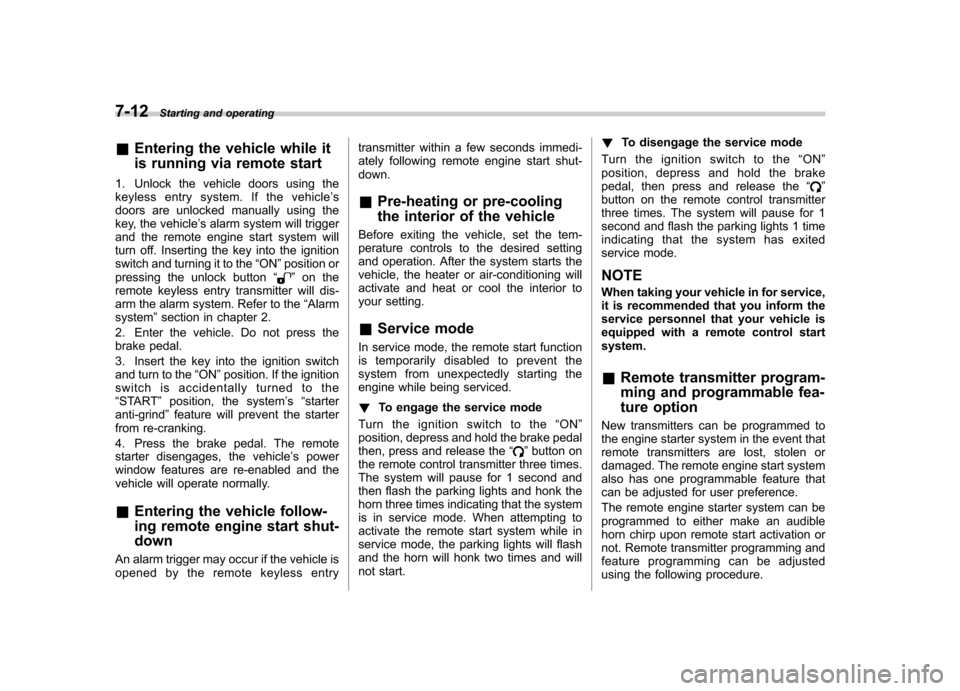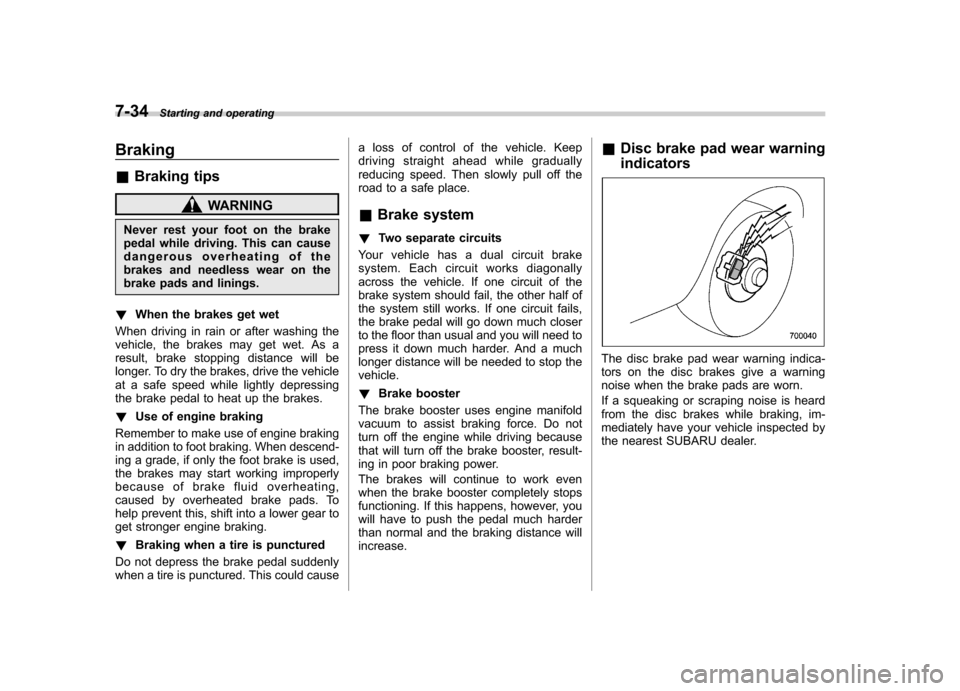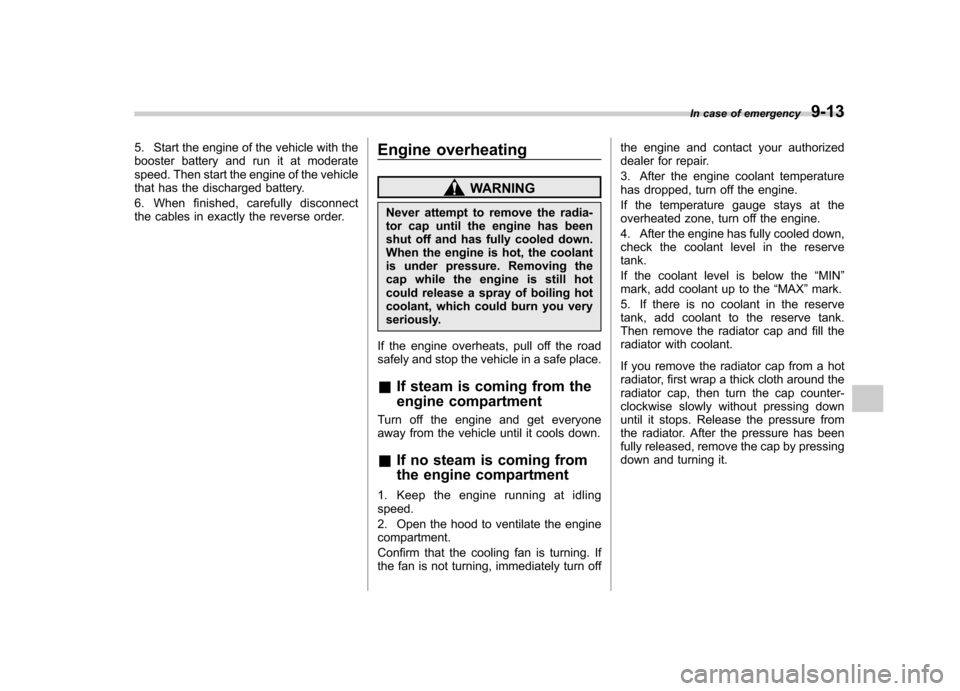2008 SUBARU OUTBACK heating
[x] Cancel search: heatingPage 253 of 444

7-12Starting and operating
& Entering the vehicle while it
is running via remote start
1. Unlock the vehicle doors using the
keyless entry system. If the vehicle ’s
doors are unlocked manually using the
key, the vehicle ’s alarm system will trigger
and the remote engine start system will
turn off. Inserting the key into the ignition
switch and turning it to the “ON ”position or
pressing the unlock button “
”on the
remote keyless entry transmitter will dis-
arm the alarm system. Refer to the “Alarm
system ”section in chapter 2.
2. Enter the vehicle. Do not press the
brake pedal.
3. Insert the key into the ignition switch
and turn to the “ON ”position. If the ignition
switch is accidentally turned to the“ START ”position, the system ’s “starter
anti-grind ”feature will prevent the starter
from re-cranking.
4. Press the brake pedal. The remote
starter disengages, the vehicle ’s power
window features are re-enabled and the
vehicle will operate normally.
& Entering the vehicle follow-
ing remote engine start shut-down
An alarm trigger may occur if the vehicle is
opened by the remote keyless entry transmitter within a few seconds immedi-
ately following remote engine start shut-down.
& Pre-heating or pre-cooling
the interior of the vehicle
Before exiting the vehicle, set the tem-
perature controls to the desired setting
and operation. After the system starts the
vehicle, the heater or air-conditioning will
activate and heat or cool the interior to
your setting. & Service mode
In service mode, the remote start function
is temporarily disabled to prevent the
system from unexpectedly starting the
engine while being serviced. ! To engage the service mode
Turn the ignition switch to the “ON ”
position, depress and hold the brake pedal
then, press and release the “
”button on
the remote control transmitter three times.
The system will pause for 1 second and
then flash the parking lights and honk the
horn three times indicating that the system
is in service mode. When attempting to
activate the remote start system while in
service mode, the parking lights will flash
and the horn will honk two times and will
not start. !
To disengage the service mode
Turntheignitionswitchtothe “ON ”
position, depress and hold the brake
pedal, then press and release the “
”
button on the remote control transmitter
three times. The system will pause for 1
second and flash the parking lights 1 time
indicating that the system has exited
service mode.
NOTE
When taking your vehicle in for service,
it is recommended that you inform the
service personnel that your vehicle is
equipped with a remote control startsystem. & Remote transmitter program-
ming and programmable fea-
ture option
New transmitters can be programmed to
the engine starter system in the event that
remote transmitters are lost, stolen or
damaged. The remote engine start system
also has one programmable feature that
can be adjusted for user preference.
The remote engine starter system can be
programmed to either make an audible
horn chirp upon remote start activation or
not. Remote transmitter programming and
feature programming can be adjusted
using the following procedure.
Page 275 of 444

7-34Starting and operating
Braking &Braking tips
WARNING
Never rest your foot on the brake
pedal while driving. This can cause
dangerous overheating of the
brakes and needless wear on the
brake pads and linings.
! When the brakes get wet
When driving in rain or after washing the
vehicle, the brakes may get wet. As a
result, brake stopping distance will be
longer. To dry the brakes, drive the vehicle
at a safe speed while lightly depressing
the brake pedal to heat up the brakes. ! Use of engine braking
Remember to make use of engine braking
in addition to foot braking. When descend-
ing a grade, if only the foot brake is used,
the brakes may start working improperly
because of brake fluid overheating,
caused by overheated brake pads. To
help prevent this, shift into a lower gear to
get stronger engine braking. ! Braking when a tire is punctured
Do not depress the brake pedal suddenly
when a tire is punctured. This could cause a loss of control of the vehicle. Keep
driving straight ahead while gradually
reducing speed. Then slowly pull off the
road to a safe place.
& Brake system
! Two separate circuits
Your vehicle has a dual circuit brake
system. Each circuit works diagonally
across the vehicle. If one circuit of the
brake system should fail, the other half of
the system still works. If one circuit fails,
the brake pedal will go down much closer
to the floor than usual and you will need to
press it down much harder. And a much
longer distance will be needed to stop thevehicle. ! Brake booster
The brake booster uses engine manifold
vacuum to assist braking force. Do not
turn off the engine while driving because
that will turn off the brake booster, result-
ing in poor braking power.
The brakes will continue to work even
when the brake booster completely stops
functioning. If this happens, however, you
will have to push the pedal much harder
than normal and the braking distance willincrease. &
Disc brake pad wear warning indicators
The disc brake pad wear warning indica-
tors on the disc brakes give a warning
noise when the brake pads are worn.
If a squeaking or scraping noise is heard
from the disc brakes while braking, im-
mediately have your vehicle inspected by
the nearest SUBARU dealer.
Page 320 of 444

!Driving on grades
. Before going down a steep hill, slow
down and shift into lower gear (if neces-
sary, use 1st gear) in order to utilize the
engine braking effect and prevent over-
heating of your vehicle ’s brakes. Do not
make sudden downshifts. . When driving uphill in hot weather, the
air conditioner may turn off automatically
to protect the engine from overheating. . When driving uphill in hot weather, pay
attention to the water temperature gauge
pointer (for all vehicles) and AT OIL TEMP
warning light (for AT models) since the
engine and transmission are relatively
prone to overheating under these condi-
tions. If the water temperature gauge
pointer approaches the OVERHEAT zone
or the AT OIL TEMP warning light illumi-
nates, immediately switch off the air
conditioner and stop the vehicle at the
nearest safe place. Refer to the “Engine
overheating ”section in chapter 9, and
“ Warning and indicator lights ”section in
chapter 3. NOTE
With AT models, the temperature of
engine coolant is less likely to rise to
the OVERHEAT zone in the “D ” posi-
tion than in the manual mode position. . If your vehicle has an automatic trans- mission, avoid using the accelerator pedal
to stay stationary on an uphill slope
instead of using the parking brake or foot
brake. That may cause the transmission
fluid to overheat. !
Parking on a grade
Always block the wheels under both
vehicle and trailer when parking. Apply
the parking brake firmly. You should not
park on a hill or slope. But if parking on a
hill or slope cannot be avoided, you
should take the following steps:
1. Apply the brakes and hold the pedal down.
2. Have someone place wheel blocks
under both the vehicle and trailer wheels.
3. When the wheel blocks are in place,
release the regular brakes slowly until the
blocks absorb the load.
4. Apply the regular brakes and then
apply the parking brake; slowly release
the regular brakes.
5. Shift into 1st or reverse gear (manual
transmission) or “P ” (automatic transmis-
sion) and shut off the engine. Driving tips
8-29
Page 321 of 444

If you park your vehicle in an emergency......... 9-2
Temporary spare tire ........................................... 9-2
Flat tires ............................................................... 9-4
Changing a flat tire .............................................. 9-4
Tire pressure monitoring system (TPMS) (if equipped) .......................................................... 9-9
Jump starting ..................................................... 9-10
How to jump start ............................................... 9-11
Engine overheating ............................................ 9-13
If steam is coming from the engine compartment .................................................... 9-13 If no steam is coming from the engine
compartment ................................................... 9-13
Towing ................................................................ 9-14
Towing and tie-down hooks. ............................... 9-14
Using a flat-bed truck. ........................................ 9-17
Towing with all wheels on the ground ................. 9-17
Rear gate (Station wagon) –if the rear gate
cannot be unlocked ........................................ 9-18
Maintenance tools ............................................. 9-19
Jack .................................................................. 9-19
Jack handle ....................................................... 9-19
Other maintenance tools .................................... 9-20
In case of emergency
9
Page 333 of 444

5. Start the engine of the vehicle with the
booster battery and run it at moderate
speed. Then start the engine of the vehicle
that has the discharged battery.
6. When finished, carefully disconnect
the cables in exactly the reverse order.Engine overheating
WARNING
Never attempt to remove the radia-
tor cap until the engine has been
shut off and has fully cooled down.
When the engine is hot, the coolant
is under pressure. Removing the
cap while the engine is still hot
could release a spray of boiling hot
coolant, which could burn you very
seriously.
If the engine overheats, pull off the road
safely and stop the vehicle in a safe place. & If steam is coming from the
engine compartment
Turn off the engine and get everyone
away from the vehicle until it cools down. & If no steam is coming from
the engine compartment
1. Keep the engine running at idling speed.
2. Open the hood to ventilate the engine compartment.
Confirm that the cooling fan is turning. If
the fan is not turning, immediately turn off the engine and contact your authorized
dealer for repair.
3. After the engine coolant temperature
has dropped, turn off the engine.
If the temperature gauge stays at the
overheated zone, turn off the engine.
4. After the engine has fully cooled down,
check the coolant level in the reservetank.
If the coolant level is below the
“MIN ”
mark, add coolant up to the “MAX ”mark.
5. If there is no coolant in the reserve
tank, add coolant to the reserve tank.
Then remove the radiator cap and fill the
radiator with coolant.
If you remove the radiator cap from a hot
radiator, first wrap a thick cloth around the
radiator cap, then turn the cap counter-
clockwise slowly without pressing down
until it stops. Release the pressure from
the radiator. After the pressure has been
fully released, remove the cap by pressing
down and turning it. In case of emergency
9-13
Page 435 of 444

14-4Index
Door Locks ..................................................................... 2-5
Open warning light ................................................. 3-36
Drive belts. ............................................................... 11-21
Driving All-Wheel Drive vehicle ........................................... 3-36
Car phone/cell phone .................................................. 7
Drinking ..................................................................... 6
Drugs ........................................................................ 6
Foreign countries ..................................................... 8-5
Pets .......................................................................... 7
Snowy and icy roads ................................................ 8-9
Tips....................................... 7-15, 7-17, 7-22, 7-29, 8-5
Tired or sleepy. ........................................................... 7
E
ECO gauge ................................................................. 3-8
Electrical system ........................................................ 12-3
Electronic Brake Force Distribution (EBD) system ........................................................... 3-35, 7-36
Emergency Locking Retractor (ELR) ............................. 1-14
Engine Compartment overview ........................................... 11-6
Coolant ................................................................ 11-14
Exhaust gas (Carbon monoxide) ............................ 6, 8-3
Hood .................................................................... 11-4
Oil........................................................................ 11-9Overheating .......................................................... 9-13
Starting ................................................................... 7-9
Stopping ............................................................... 7-10
Exterior care .............................................................. 10-2 F
Flat tires
..................................................................... 9-4
Floor mat ................................................................... 6-12
Fluid level Automatic transmission ......................................... 11-23
Brake .................................................................. 11-29
Clutch ................................................................. 11-30
Power steering ..................................................... 11-28
Fog light switch .......................................................... 3-48
Front Differential gear oil ................................................ 11-24
Fog light .............................................................. 11-54
Seatbelt pretensioners ............................................ 1-24
Seats ..................................................................... 1-2
Front seats Fore and aft adjustment ..................................... 1-3, 1-4
Reclining .......................................................... 1-3, 1-4
Fuel ........................................................................... 7-3
Economy hints ........................................................ 8-2
Filler lid and cap ...................................................... 7-5
Gauge ............................................................ 3-6, 3-26
Requirements ......................................................... 7-3
Fuses ..................................................................... 11-48
Fuses and circuits ...................................................... 12-6
G
GAWR (Gross Axle Weight Rating) ............................... 8-15
Gear position indicator ................................................ 3-39
Glove box ................................................................... 6-5
GVWR (Gross Vehicle Weight Rating) ... ........................ 8-15
Page 437 of 444

14-6Index
Light Cargo area .............................................................. 6-2
Control switch ........................................................ 3-45
Dome ..................................................................... 6-2
Map ....................................................................... 6-2
Limited slip differential (LSD) ....................................... 7-33
Loading your vehicle .................................................. 8-13
Low fuel warning light ................................... 3-7, 3-27, 3-35
Low tire pressure warning light .................................... 3-32
Lower and tether anchorage ........................................ 1-35
LSD (Limited slip differential) ....................................... 7-33
Lumbar support ........................................................... 1-8
M
Main fuse ................................................................. 11-49
Maintenance Precautions ........................................................... 11-3
Schedule .............................................................. 11-3
Seatbelt ................................................................ 1-23
Tools .................................................................... 9-19
Malfunction indicator lamp ........................................... 3-31
Manual Climate control system ............................................. 4-3
Mode ............................................................ 7-21, 7-27
Seat ....................................................................... 1-3
Transmission oil .................................................... 11-21
Transmission-5 speeds ........................................... 7-14
Transmission-6 speeds ........................................... 7-16
Map light ........................................................... 6-2, 11-59
Maximum load limits ................................................... 8-22
Meters and gauges .............................................. 3-5, 3-24 Mirrors
...................................................................... 3-55
Moonroof ................................................................... 2-27
Multi-information display ............................................... 3-9
N
New vehicle break-in driving ......................................... 8-2
O Odometer .................................................................. 3-25
Odometer/Tripmeter .................................................... 3-10
Off road driving ........................................................... 8-6
Oil filter ................................................................... 11-10
Oil level
Engine .................................................................. 11-9
Front differential gear ............................................ 11-24
Manual transmission ............................................. 11-21
Rear differential .................................................... 11-25
Oil pressure warning light ............................................ 3-32
Outside mirrors .......................................................... 3-57
Outside temperature indicator ...................................... 3-41
Overhead console ....................................................... 6-7
Overheating engine .................................................... 9-13
PParking Brake .................................................................... 7-45
Brake stroke ........................................................ 11-33
Light switch ........................................................... 3-48
Tips ...................................................................... 7-45
Parking your vehicle ................................................... 7-44
Pcket ......................................................................... 6-7